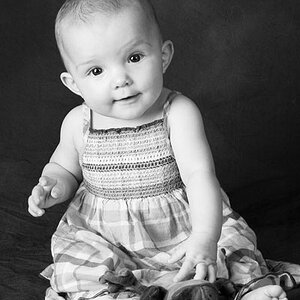Navigation
Install the app
How to install the app on iOS
Follow along with the video below to see how to install our site as a web app on your home screen.

Note: This feature currently requires accessing the site using the built-in Safari browser.
More options
You are using an out of date browser. It may not display this or other websites correctly.
You should upgrade or use an alternative browser.
You should upgrade or use an alternative browser.
LCD vs CRT
- Thread starter Big Mike
- Start date
Digital Matt
alter ego: Analog Matt
- Joined
- Jan 30, 2004
- Messages
- 5,358
- Reaction score
- 73
- Location
- Santa Barbara, CA
- Website
- www.mattperko.com
- Can others edit my Photos
- Photos NOT OK to edit
I seem to remember getting into this conversation before about the spyder. There should be no reason that you cannot calibrate multiple monitors. The unit does not know what monitor it is on. It should create a profile based on the photons it is receiving. Drag the software to the 2nd monitor, hang the spyder on it, and go for it. Name the newly created profile as "monitor2_date" and you can assign it to your 2nd monitor via your video card software.
skieur
TPF Noob!
- Joined
- May 14, 2007
- Messages
- 5,071
- Reaction score
- 204
- Location
- Canada
- Can others edit my Photos
- Photos OK to edit
When PHOLEDs come in, then I will switch to flat screen. They have been at the major electronics shows but they have not been marketted yet. They will certainly make LCDs obsolete in both screens and viewfinders and they use a lot less energy.
skieur
skieur
PhotoPhoenix
TPF Noob!
- Joined
- Jun 24, 2007
- Messages
- 126
- Reaction score
- 0
- Location
- New York City, NY
- Website
- www.flick.com
- Can others edit my Photos
- Photos OK to edit
In an extensive book on Colour Correction for Digital Photographers, it says clearly : The CRT is the tool of choice for colour specialists and better represents printed colour and clarity than LCDs.
skieur
yeap, that's how i was always taught. LCD monitors are oversaturated and pretty. CRT monitors are more correct..when calibrated.
- Joined
- Dec 16, 2003
- Messages
- 33,896
- Reaction score
- 1,853
- Location
- Edmonton
- Website
- www.mikehodson.ca
- Can others edit my Photos
- Photos NOT OK to edit
I remember you saying that before. I haven't tried it yet...but I will. With one monitor, the software automatically loads the new profile...so I'd have to find where to load the profile for the separate monitors...shouldn't be too hard...in theory.I seem to remember getting into this conversation before about the spyder. There should be no reason that you cannot calibrate multiple monitors. The unit does not know what monitor it is on. It should create a profile based on the photons it is receiving. Drag the software to the 2nd monitor, hang the spyder on it, and go for it. Name the newly created profile as "monitor2_date" and you can assign it to your 2nd monitor via your video card software.
Digital Matt
alter ego: Analog Matt
- Joined
- Jan 30, 2004
- Messages
- 5,358
- Reaction score
- 73
- Location
- Santa Barbara, CA
- Website
- www.mattperko.com
- Can others edit my Photos
- Photos NOT OK to edit
Mike, right click on your desktop and go to properties, and then the settings tab. This will show icons for both of your monitors. Click on monitor 2 and click the advanced button. I don't know what video card you have, but there is probably a tab for "color" and in that tab you set the monitor profile.
- Joined
- Dec 16, 2003
- Messages
- 33,896
- Reaction score
- 1,853
- Location
- Edmonton
- Website
- www.mikehodson.ca
- Can others edit my Photos
- Photos NOT OK to edit
Excellent...thanks Matt.
I've had my CRT turned on for a day or two now...and I think it's looking better (I haven't really check on it lately). I'll try to calibrate it again tonight.
b.t.w. To be able to hook up a second monitor, I bought another video card...with the idea that I could install two video cards and run one monitor off of each. Then when I went to install it...there is only one slot on the mother board that will accept a video card. (I'm not as computer savey as I used to be). Anyway, the new card has a couple different out-put options and it came with a converter plug, so I plugged both monitors into the card and it's working. I think I got a pretty good deal on it, it's a Radeon 700XT, or something like that, and I paid $60 CDN.
I also found a WD 250 Gig hard drive and installed that as well.
I've had my CRT turned on for a day or two now...and I think it's looking better (I haven't really check on it lately). I'll try to calibrate it again tonight.
b.t.w. To be able to hook up a second monitor, I bought another video card...with the idea that I could install two video cards and run one monitor off of each. Then when I went to install it...there is only one slot on the mother board that will accept a video card. (I'm not as computer savey as I used to be). Anyway, the new card has a couple different out-put options and it came with a converter plug, so I plugged both monitors into the card and it's working. I think I got a pretty good deal on it, it's a Radeon 700XT, or something like that, and I paid $60 CDN.
I also found a WD 250 Gig hard drive and installed that as well.
sabbath999
No longer a newbie, moving up!
- Joined
- Apr 11, 2007
- Messages
- 2,701
- Reaction score
- 71
- Location
- Missouri
- Can others edit my Photos
- Photos OK to edit
Excellent...thanks Matt.
I've had my CRT turned on for a day or two now...and I think it's looking better (I haven't really check on it lately). I'll try to calibrate it again tonight.
b.t.w. To be able to hook up a second monitor, I bought another video card...with the idea that I could install two video cards and run one monitor off of each. Then when I went to install it...there is only one slot on the mother board that will accept a video card. (I'm not as computer savey as I used to be). Anyway, the new card has a couple different out-put options and it came with a converter plug, so I plugged both monitors into the card and it's working. I think I got a pretty good deal on it, it's a Radeon 700XT, or something like that, and I paid $60 CDN.
I also found a WD 250 Gig hard drive and installed that as well.
Ok, depending on your computer, you (likely) either have a AGP card or a PCIe card. Your box should say which.
If you have an AGP card, you can always just pick up a cheap PCI card as your second video card... unless you game with it, that setup will do just fine. The best option is to buy a dual output card... some Radeon's are, and some are not... depending on the manufacturer.
Also, don't forget to degauss your CRT before you calibrate...
- Joined
- Dec 16, 2003
- Messages
- 33,896
- Reaction score
- 1,853
- Location
- Edmonton
- Website
- www.mikehodson.ca
- Can others edit my Photos
- Photos NOT OK to edit
Thanks for the insight.
I'm not sure but it sounds like I have an AGP card...and my idea was to get a cheap PCI card. I unknowing bought another AGP card...but luckily it allows for dual output...although I'm not sure it is a typical 'dual output' card because the output connections are different. Actually, I think there are 4 different outputs...one is the typical monitor plug, another one is similar but a little bit bigger, one is S-Video and the other is the standard yellow video out that would be on home entertainment equipment. The card is 'TV OUT', so I guess I could run a cable to my TV as well.
It's seems to be working fine...so I think it's going to be OK. The only think that might be wonky is if I can't load separate profiles for the two monitors...but I'll try that some time soon.
I'm not sure but it sounds like I have an AGP card...and my idea was to get a cheap PCI card. I unknowing bought another AGP card...but luckily it allows for dual output...although I'm not sure it is a typical 'dual output' card because the output connections are different. Actually, I think there are 4 different outputs...one is the typical monitor plug, another one is similar but a little bit bigger, one is S-Video and the other is the standard yellow video out that would be on home entertainment equipment. The card is 'TV OUT', so I guess I could run a cable to my TV as well.
It's seems to be working fine...so I think it's going to be OK. The only think that might be wonky is if I can't load separate profiles for the two monitors...but I'll try that some time soon.
glaston
TPF Noob!
- Joined
- Jul 4, 2007
- Messages
- 216
- Reaction score
- 0
- Can others edit my Photos
- Photos NOT OK to edit
AGP slots are green, and are the top slot directly below the CPU slot on the mainboard. PCI slots are white, and reside below the AGP slot.
PCIx slots are actually faster than even the newest AGP generation.
I've been working with multi-display systems for years.
And there are some issues that aren't immediately apparent.
The general rule is that it's always best to use identical cards for both displays. Simply because they will both run in sync with each other.
It's easy to grab an older PCI card and throw it in as a secondary display.
However, if you extend your desktop onto the 2nd display and it has less memory than the primary display, it will inevitably cause problems at some point.
A system I had in the late 90's with an AGP display as the primary(3DLabs Oxygen VX1 card), and a PCI card as the 2ndary(Matrox Millenium card) would consistently shutdown the whole system while using pretty much ANY design application if I had the app windows spanned over both displays.
There's also issues with hardware overlay in some cards, which designate one display (primary display) to be used with hardware overlay.
This can be seen in many laptops with TV out functions, which require the TV to be the primary display in order to show a DVD on it.
This isn't a concern with a system running an OSX certified card under MacOS X 10.2 or above, or a Windows Vista certified card running under Vista.
As these OS' use desktop compositing.
Most cards come in AGP and PCI versions, and if you have an AGP card it's best to get a PCI version of the same card for the 2nd display.
PCIx slots are actually faster than even the newest AGP generation.
I've been working with multi-display systems for years.
And there are some issues that aren't immediately apparent.
The general rule is that it's always best to use identical cards for both displays. Simply because they will both run in sync with each other.
It's easy to grab an older PCI card and throw it in as a secondary display.
However, if you extend your desktop onto the 2nd display and it has less memory than the primary display, it will inevitably cause problems at some point.
A system I had in the late 90's with an AGP display as the primary(3DLabs Oxygen VX1 card), and a PCI card as the 2ndary(Matrox Millenium card) would consistently shutdown the whole system while using pretty much ANY design application if I had the app windows spanned over both displays.
There's also issues with hardware overlay in some cards, which designate one display (primary display) to be used with hardware overlay.
This can be seen in many laptops with TV out functions, which require the TV to be the primary display in order to show a DVD on it.
This isn't a concern with a system running an OSX certified card under MacOS X 10.2 or above, or a Windows Vista certified card running under Vista.
As these OS' use desktop compositing.
Most cards come in AGP and PCI versions, and if you have an AGP card it's best to get a PCI version of the same card for the 2nd display.
Digital Matt
alter ego: Analog Matt
- Joined
- Jan 30, 2004
- Messages
- 5,358
- Reaction score
- 73
- Location
- Santa Barbara, CA
- Website
- www.mattperko.com
- Can others edit my Photos
- Photos NOT OK to edit
Mike, likely one of the monitor connections on your new card is DVI. You can buy an adapter to transfer from DVI to VGA (vga is the cable you will be using from your crt). You can find these adapters fairly cheap online. Check out www.tigerdirect.com or www.newegg.com.
Similar threads
- Replies
- 3
- Views
- 181
- Replies
- 6
- Views
- 659



![[No title]](/data/xfmg/thumbnail/34/34116-b81991a4a8a532509a981cadbacd573c.jpg?1619736286)

![[No title]](/data/xfmg/thumbnail/39/39187-9ec2507d9e5ef2843f7f00127c7abb4c.jpg?1619738905)



![[No title]](/data/xfmg/thumbnail/35/35968-01893eeb6a205c00827118fe5bb79703.jpg?1619737286)

![[No title]](/data/xfmg/thumbnail/41/41764-1385c153e9fea917b7efea0bbde7eefe.jpg?1619739885)
